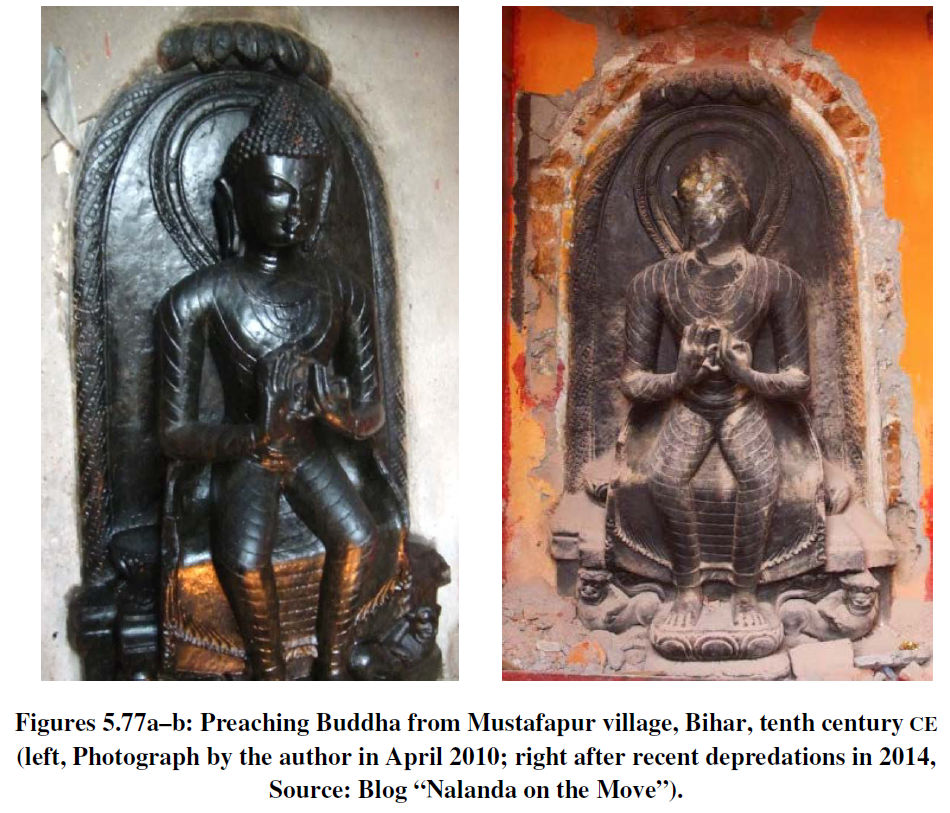Nicolas Revire. 2016. ‘The Enthroned Buddha in Majesty: An Iconological Study’. PhD diss. (Religions), Université Sorbonne Paris Cité. 2 vols., 410+299 pp. HAL ID: <tel-01552082>. [PDFs: vol.1, vol.2] [author: academia.edu]

From the Abstract: This dissertation consists of a detailed study of a particular representation of the Buddha, in which he sits on a prominent throne, i.e. a bhadrapīṭha or bhadrāsana, in a majestic posture with two legs pendant, that is, in bhadrāsana or the “auspicious pose.” This pendant-legged imagery, generally associated with a throne, has been found widely depicted in ancient religious art associated with early urban complexes and is, as a rule, mostly associated with kingship, fertility, and even divinity. […] In sum, the dissertation traces the roots and original significance of this specific iconographic type in South Asia as well as its chronological development and subsequent spread in East and Southeast Asia by both land and maritime trade routes. To achieve this goal, a comprehensive corpus has been assembled of Buddha images, as well as other deities similarly seated in (and on a) bhadrāsana. Particular attention is paid to those images which have secure provenances, are securely dated, and are identified by inscriptions — although these last are regrettably rare. […] The research finally deals, on a case by case basis, with the difficult and controversial issue of the identification of such enthroned Buddhas in majesty. It can on the whole be demonstrated that this iconography can either represent a past, present, or future Buddha, the latter especially ― if not exclusively ― in the art of East Asia and, in a later period, in the Himalayas. […]
Abstract … i
Résumé … iii
Acknowledgements … v
Technical Notes … vii
List of Abbreviations & Acronyms … ix
CHAPTER 1: PROLEGOMENA … 1
1. Research Scope, Problems, and Methodology … 2
2. East or West? The Quest for Origins … 5
2.1 Anatolia and Mesopotamia: The Cradle of Early Civilizations … 5
2.2 The Greek and Hellenistic World … 7
2.3 The Indian Subcontinent … 9
3. Questions of Terminology … 11
3.1 A “European Posture”? Foucher Revisited … 11
3.2 Sanskrit Terminology: Back to Coomaraswamy … 12
4. Descriptions of bhadrāsana … 13
4.1 Early Sitting Apparatus in India … 14
4.2 The bhadrāsana as Royal Throne … 16
4.3 The bhadrāsana as a Sitting Posture … 24
5. Summary and Discussion … 29
CHAPTER 2: GREATER GANDHĀRA AND THE NORTHWEST … 32
1. Historical Geography … 32
2. A Graeco-Buddhist Art? … 33
2.1 Definition … 33
2.2 Royal and Divine Portraits on Kuṣāṇa Coins … 34
3. Corpus Analysis … 39
3.1 Narrative Art … 39
3.2 Iconic Art … 46
4. Summary and Discussion … 63
4.1 From Auspicious Yakṣas to Bhadrāsana Buddhas? … 63
4.2 On the Appearance of the First Preaching Bhadrāsana Buddha Image … 64
CHAPTER 3: ANDHRA PRADESH AND THE LOWER EASTERN DECCAN … 66
1. Historical Geography … 66
2. Corpus Analysis … 69
2.1 The Early Period (ca 200 BCE–200 CE) … 69
2.2 The Later Period (ca 200 CE–Onwards) … 78
3. Summary and Discussion: From Empty Thrones to Enthroned Buddhas? … 94
CHAPTER 4: NORTH-CENTRAL INDIA AND THE WESTERN DECCAN CAVES … 98
1. Historical Overview … 98
1.1 The Gupta Period (ca 320–550 CE) … 98
1.2 The Vākāṭaka Empire (ca 250–477 CE) … 100
2. The Religious Environment … 102
2.1 The Sudden Growth of Mahāyāna Buddhism(s) … 102
2.2 The Question of Buddhist Patronage … 104
2.3 The Rise of Hinduism … 106
3. Corpus Analysis … 108
3.1 Defining Features: A Gupta-period Art Style? … 108
3.2 Non-Buddhist Deities … 109
3.3 Buddhist Sculptures from Sārnāth … 121
3.4 Buddhist Sculptures from Madhya Pradesh and Gujarat … 129
3.5 Paintings and Sculptures from the Western Deccan Caves … 133
4. Summary and Discussion … 207
4.1 A Royal and Solar Iconography? … 207
4.2 The Buddha as “Pantokrator” … 209
xii
CHAPTER 5: EASTERN INDIA (BIHAR, BENGAL, ORISSA) AND THE HIMALAYAS … 214
1. The Pāla-Sena Classical Age (ca 737–1200 CE) … 214
2. Corpus Analysis … 216
2.1 Hindu Sculptures from Bihar, Bengal, and the Himalayas … 216
2.2 Buddhist Sculptures from Bihar … 220
2.3 Buddhist Sculptures from Bengal … 272
2.4 Buddhist Sculptures from Orissa … 275
2.5 Buddhist Sculptures from the Himalayas … 276
3. Summary and Discussion: From Enthroned to Crowned Buddhas? … 292
CHAPTER 6: EPILEGOMENA ― “OUT OF INDIA” … 294
1. A Widespread Iconography in East and Southeast Asia … 295
2. The Tang Ascendancy and Maritime Interactions with Southeast Asia … 299
3. An Ideal Model? The “King Udayana” Images of Longmen … 304
4. Initial Spread of Bhadrāsana Buddhas in Southeast Asia (ca 650–750 CE) … 308
5. Later Spread of Bhadrāsana Buddhas in Southeast Asia (ca 750 CE–Onwards) … 309
APPENDIX A: Solar Symbolism in Early Buddhist Literature … 315
APPENDIX B: Legends of the First (Seated) Buddha Image … 327
References … 334

